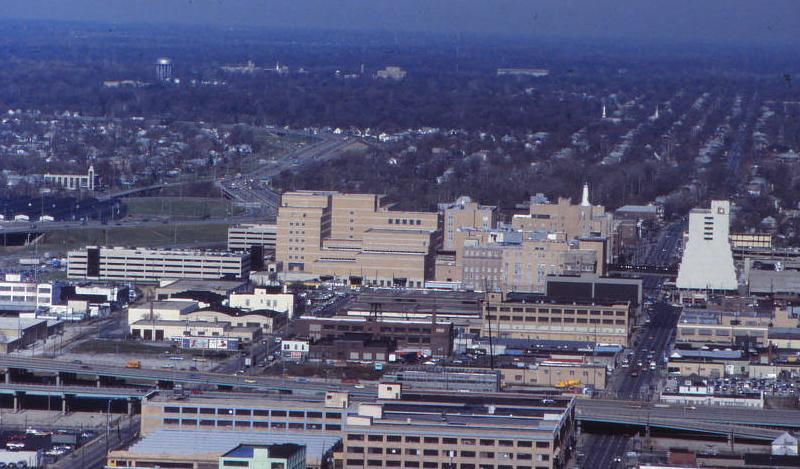Methodist Hospital began as a ministry of the Methodist church and, as a founding member of Indiana University Health, brought an early emphasis on values to the work of the health system.

In July 1899, Indianapolis hosted the Fourth Annual International Convention of the Epworth League of the Methodist Episcopal Church, which brought more than 10,000 delegates to the city. The convention was such a success that after all the bills were paid, $4,750 (a substantial sum in those days) remained in the convention fund. The convention committee donated the money to a building fund for the construction of a new hospital for the city of Indianapolis, an action approved by the Indiana Conference. Rev. Leslie J. Naftzger was elected the first president of the board of trustees.
The cornerstone for the first building was laid on October 25, 1905, at the building site at Capitol Avenue and 16th Street (then Tinker Street), earlier a baseball park for the . Designed by August Bohn of architects, the building was completed in April 1908, at a cost of $225,000. The new hospital had 65 beds, 37 private rooms, 4 large wards, and 3 small wards. The three-story fireproof structure boasted modern surgical rooms with floors and walls of white glass. The hospital had portable bathtubs, plumbing equipped with pedal action, dumbwaiters operated by pushbuttons, and a call system of signal lights that “eliminated the continuous noise of clanging bells.” Singled out for special praise, the new “plunger type” hospital elevator worked by means of water pressure and was large enough to hold a patient litter.
A handwritten report in 1909 declared that 880 patients were cared for at Methodist in its first full year of operation. The hospital’s emphasis on training also began early, with two interns and a group of nurses in training the first year.
The hospital opened its first X-ray department in 1909. Dr. Albert M. Cole installed one of the earliest X-ray machines in a tiny, unused hospital room. The device used a Crookes gas tube and heavy glass plates. Because the hospital had no facilities for developing the plates, they had to be taken downtown, usually by a messenger on the electric streetcar, to Dr. Cole’s office for processing. Methodist’s long and continuing relationship with the was also established early when doctors and nurses from the hospital were stationed at the track in case of emergencies.
Almost before the first building was completed, Methodist needed to expand its facilities. In 1910, the board of trustees voted to add two pavilions at a cost of $250,000. By 1916, both pavilions were in operation and the number of beds had increased to 250, making the hospital the largest in the state, a ranking it retained in the early twenty-first 21st century. In 1933, Mary Hanson Carey donated the hospital’s most famous landmark, the Lighthouse of Health Beacon which sits atop one of the older buildings.
In concert with , Methodist was one of the primary centers for clinical research in the use of to treat diabetes mellitus, beginning in August 1922, when the first units of insulin were given to its patients. Clinical research in diabetes was only the beginning of many areas of research achievement for the institution. On October 30, 1982, the hospital recorded its first heart transplant (the first in a private hospital anywhere in the world). On February 23, 1984, the hospital was the site of the nation’s first use of an extracorporeal shock wave lithotripter, a device that pulverizes kidney stones using shock waves. Methodist continued to be a center of medical innovation and quality through the 1990s and into the new century. The University Health Consortium ranked Methodist among the top hospitals in the country for safety and quality in 2007, 2008, 2009, and 2010.
In 1994, the establishment of the Methodist Health Group and the Methodist Medical Network formed a critical step toward a statewide integrated health system. The health system began to decentralize some of its services by locating several outpatient centers near the I-465 beltway.
In 1997, Methodist consolidated with Indiana University Hospital and , the major health care facilities of the , to form Clarian Health Partners. Over time, Clarian grew to include not only Methodist, Riley, and University Hospital but also other hospitals and health centers throughout Indiana.
In 2011, Clarian became . This name change was put in place to “better identify Clarian’s unique brand of nationally recognized health care, reinforce its partnership with Indiana University and the , which provides patients with access to innovative research and treatments, and better reflect the breadth of its mission.” In conformance with brand standards, Methodist gained the name Indiana University Health Methodist Hospital. IU Health continues to function as a private, not-for-profit corporation with members of the United Methodist Church and the Indiana University Board of Trustees serving on the board.

Help improve this entry
Contribute information, offer corrections, suggest images.
You can also recommend new entries related to this topic.